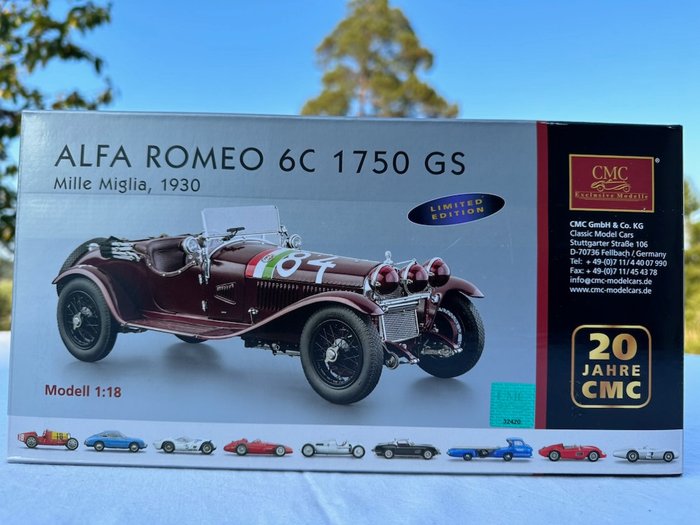
CMC 1:18 - Modellauto -Winner set Nuvolari Alfa Romeo P3 GP France, Coppa Ciano, Coppa Acerbo, 1932 - (Code PC42)
Nr. 81624641

Nr. 81624641

Alfa-Romeo 6C 1750 GS #84 Nuvolari. Mille Miglia 1930
Limited Edition: ONLY 2,000 pcs world wide
I´m downsizing my private collection of exclusive modelcars.
This is a hand assembled precision model, and an absolutely stunning model.
A gem in your collection!
Perfect gift or for the race car collector or the Alfa Romeo fan.
Extremly rare & very hard to find rarity model!
Brand new!
100% mint in SEALED never opened innerbox as seen in the pictures.
Reference pictures of the car as the innerpackaging is sealed.
Driver: Tazio Nuvolari
Co pilot: Guidotti
CMC model cars are extraordinarly detailed, with excellent quality, & probably the finest model cars available.
Details:
Hand-assembled precision metal model with right-hand drive, built from 1,800 single parts, of which 1,311 are made of metal
True-to-scale, authentic replication of the Spyder body customized by the renowned coachbuilder Zagato
Metal framing of multiple body parts
Highly detailed 6-cylinder in-line engine, complete with all aggregates, pipes and cabling in addition to a front-mounted Roots supercharger and accessories
Distinctiv Alfa Romeo front end with the famous triple-headlight unit
Headlights fitted with mesh guards against stone-chip damages. The red caps are removable
Double-winged engine hood that opens to rest on metal studs
Finely-woven metal grille to protect the radiator fins
Windshield with a semi-fixed metal mounting-frame
Functional doors mounted on finely-recreated hinges
One lateral filler of the oil tank located within the cockpit, and one rear filler of the fuel tank made of stainless steel, each with a flip-open cap
Luggage space with a functional lid behind the folded textile top
Highly-detailed cockpit with upholstered leather seats and door trimmings
Precise recreation of the dashboard with all instruments and controls
Functional brackets for holding the two spare wheels. Loosening a tommy screw releases the spare wheels
Perfectly-wired wheels with a light alloy rim, stainless steel spokes and nipples
Unscrew the central locking nuts (with side-dependent right- and left-hand threads) to remove the wheels
Elaborate undercarriage, which reveals a "cast metal" type of front/rear axles as well as the fine detailing of the mechanical brake riggings, leaf springs, and friction-shock absorbers, all being made of metal
History (Original Car)
The 6C 1750 GS was designed as a racing car, and it proved to be a cut above its contemporary rivals, primarily because of its excellent acceleration on top of a simple chassis design and mechanical reliability. Another contributing factor was the exceptional response from the throttle and engine.
The well-tuned suspension, which was stiff but not too hard, enabled an energy-effective driving style.
With a curb weight of 920 kg and an output of 85 hp at 4500/min, the Gran Sport reached 145 km/hr, an amazing speed for a 1930 car that was well below two liters of displacement.
For most challenging races, Alfa Romeo equipped its official GS racing cars with fused cylinder heads and an eight-bearing crankshaft to muster 102 hp at 5000/min.
Later on, the curb weight was reduced to 840 kg, enabling the 1930 GS to be capable of reaching a top speed up to 170 km/hr.
Apparently, such technological improvements gave Tazio Nuvolari and his co-pilot Guidotti an advantage as they raced their 6C 1750 GS with starting no. 84 in the 1930 Mille Miglia endurance race.
But their arch-rival Achille Varzi was also driving a 6C 1750 GS, so a heated competition unfolded between them.
Drivers of both cars exerted their skills to the utmost and even employed tricky maneuvers.
Legend has it that under the cover of nightfall, Nuvolari turned off the headlights as his car drew closer and closer to Varzi from behind.
When he was right behind his opponent, Nuvolari suddenly switched on the three glaring headlights and surpassed a bedazzled Varzi at full speed to win the race.
Since then, the three headlights capped with red plastic covers have been one of the most distinctive features for identifying the pre-war racing models made by Alfa Romeo.
It should be mentioned that at the 1930 Mille Miglia, the first four places in the overall standings were all taken by Alfa factory cars, with the winner Tazio Nuvolari achieving an average speed of over 100 km/hour.
A true masterpiece of architecture model!
Items will be carefully packed and sent with tracking information.
So kaufen Sie auf Catawiki
1. Etwas Besonderes entdecken
2. Höchstgebot abgeben
3. Sichere Zahlung durchführen